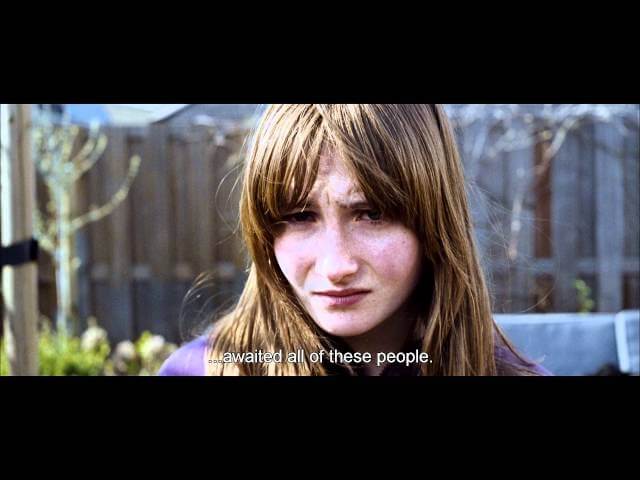TIFF '11: Day Two

Into The Abyss
Director/Country/Time: Werner Herzog/USA/106 min.
Documentary
Program: Real To Reel
Headline: In Rick Perry’s Texas, A Culture Of Death
Scott’s Take: Werner Herzog is against the death penalty. He makes that explicit upfront in Into The Abyss, his latest documentary, and he questions the necessity of it whenever the occasion arises. However, his film isn’t about the death penalty so much as it is a moving disquisition on violent death itself, and how it transforms anyone connected to it—victims, perpetrators, and those who work in the Death House. The two young men convicted in a 10-year-old triple murder in small-town Texas—one serving a life sentence, the other a week away from execution—have conflicting stories about who did what, and both protest their innocence. Though Herzog gives them room to make their case, Into The Abyss isn’t a Paradise Lost-style documentary about wrongful conviction. Instead, it collects testimony from a range of different people, including the victims’ families, the locals, and, most poignantly, a chaplain who accompanies inmates on the gurney and a Death House team leader whose pro-death penalty convictions withered away after escorting dozens of men (and the first woman) to their deaths. Herzog’s queries are typically odd at times, but his frankness and gentle curiosity gets his subjects talking and he seems to get the most out of every one of them. (If he weren’t so busy making films, Herzog would be the ideal host of a Marc Maron-like podcast.)
Grade: B+
Among Us
Director/Country/Time: Marco van Geffen/The Netherlands/84 min.
Cast: Dagmara Bak, Natalia Rybicka, Rifka Lodeizen
Program: Discovery
Headline: The hand that rocks the cradle is most likely from another country
Noel’s Take: In Marco van Geffen’s puzzle-drama Among Us, a Dutch couple hires a young Polish woman, played by Dagmara Bak, to be the nanny to their toddler, but quickly get creeped-out and later exasperated by how quiet she is, and how uninterested she seems to be in socializing or leaving the house. When the couple reaches their limit, they sack Bak, and then Among Us doubles back to retell the story from the perspective of another Polish nanny, who fills in some of the details of Bak’s strange behavior. Then it doubles back one more time, to tell the story from Bak’s perspective, and thus complete the picture… sort of. Among Us is precisely paced and framed—always making sure to record the relationships between the adult characters, the children, and the various status objects they arrange around themselves—in ways that recall Michael Haneke at his most mysterious. But my major hesitation with the film is that I’m honestly not sure I “got it.” I thought I knew what Bak’s big secret was going to be, but van Geffen never expressly states it, and the last shot of Among Us reveals something wholly unexpected, casting what’s gone before in a new light. I’d have to see the movie again to figure out how it all fits together. But to van Geffen’s credit, a re-watch wouldn’t be a chore, since Among Us’ depiction of everyday cultural misunderstandings and assumptions is well-sketched and gripping even when it’s oblique.
Grade: B
The Artist
Director/Country/Time: Michel Hazanavicius/France/100 min.
Cast: Jean Dujardin, Bérénice Bejo, John Goodman
Program: Special Presentations
Headline: Hooray for Hollywood!
Noel’s Take: Though it’s set in the late ‘20s and intended as a black-and-white silent movie homage, Michel Hazanavicius’ The Artist doesn’t much resemble the movies it’s paying tribute to. It’s closer to Singin’ In The Rain and A Star Is Born—two tales of unlikely romance in Old Hollywood—than it is to Chaplin or Griffith. Jean Dujardin plays a dashing movie star who falls in love with ambitious extra Bérénice Bejo and helps her launch her own career. Then talking pictures arrive, and the Bejo’s star rises while Dujardin’s falls. The Artist’s arc is way too predictable, and on the whole it’s nowhere near as emotionally impactful as the movies it nods to. (It doesn’t help that Hazanavicius drags out the “on the skids” section far longer than he needs to.) But throughout, Hazanavicius finds clever, poetic ways to illustrate the allure of Golden Age Hollywood stardom, whether it’s Bejo dancing with Dujardin’s empty tuxedo or the couple falling in love while doing multiple takes of a scene. And the ending is boffo. Without giving too much away, when the question “One more?” gets answered “With pleasure,” it’s not just the characters talking, but Hazanavicius himself standing up for this magical era of cinema. One more? Why not?
Grade: B+
Chicken With Plums
Director/Country/Time: Marjane Satrapi & Vincent Paronnaud/France/91 min.
Cast: Mathieu Amalric, Edouard Baer, Maria De Medeiros
Program: Special Presentations
Headline: A recipe for heartbreak
Noel’s Take: Unlike Marjane Satrapi and Vincent Parranoud’s animated adaptation of Satrapi’s graphic autobiography Persepolis, their big-screen take on Satrapi’s comic Chicken With Plums was shot with actors on sets. And yet in some ways it's even cartoonier than Persepolis. Mathieu Almaric stars as a melancholy violinist who decides that life has lost all potential for pleasure, and so he decides to take to his bed and wait for death. Chicken With Plums goes day-by-day with the deathwatch, and on each day explores a piece of the hero’s history, or examines the past and future of a member of his family, or digresses into outright folklore. Just as the story combines the fantastical with the biographical (based on Satrapi family legends), so does the filmmaking veer from straightforward drama to something more outsized. The tonal shifts don't always work—there’s a fake sitcom sequence that bombs badly, for example—but the nested narrative structure gives the movie a sense of inevitability that makes it all the more powerful when Almaric’s wife and kids try to figure out what could make him happy. What they don’t realize is that his depression only has a little to do with them, and a lot to do with living for decades under the heavy boot of fate.
Grade: B+
Goodbye First Love
Director/Country/Time: Mia Hansen-Løve/France/110 min.
Cast: Lola Créton, Sebastian Urzendowsky, Magne Brekke
Program: Contemporary World Cinema
Headline: Young hearts beat free, then they go on to do other stuff
Noel’s Take: At one point in Mia Hansen-Løve’s Goodbye First Love, an architecture professor lectures his students about “glimmer,” which he defines as that quality of light that can turn an ordinary structure into something special. Goodbye First Love has that glimmer in spades. In telling the story of a teenage romance that ends in heartbreak—and then following the decade-long aftermath—Goodbye First Love is covering dramatic ground so well-trod that it may as well be paved. But the details of the piece are wholly Hansen-Løve. Beginning with the last weeks of a passionate romance—which ends when the dreamy Sebastian Urzendowsky leaves the moody Lola Créton to go on a 10-month trip and then gradually slacks off on letters and phone calls— Hansen-Løve evokes the burning intensity of young love, and how it can be so painful for the participants that being together is more miserable than breaking up. We then see Créton struggle to get her head straight in the ensuing years, until she finally settles in with an older man (that professor from above, played by Magne Brekke) and launches a promising architecture career of her own. Inevitably, Urzendowsky returns and the exes fall back into old patterns, only now it’s Urzendowsky who seems like the clingy, immature one. Goodbye First Love sometimes tells when it should show; and there’s a heavy measure of predictability to its plot. But that’s only because the situation is so common in real life: the devotion that borders on suffocation, the hurt that feels like it'll never go away, and the maturation that leads to a different set of priorities. Hansen-Løve both romanticizes the fervor of adolescent relationships—particularly the way that young lovers feel prematurely like grown-ups—and illustrates why they’re untenable. The result is a movie that’s poignant, bittersweet, and true.
Grade: A-






































